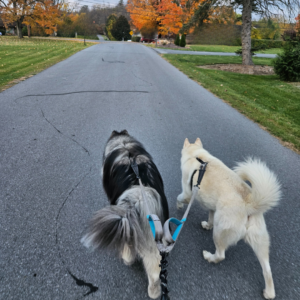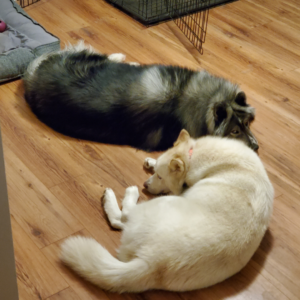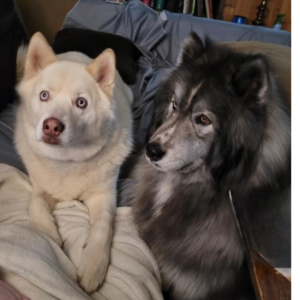Huskies are one of the most strikingly beautiful and energetic dog breeds. With their piercing blue or multi-colored eyes, fluffy double coats, and wolf-like appearance, they are a dream for many dog lovers. However, owning a Husky is not for everyone. These dogs have unique traits and needs that require careful consideration. I have two Husky boys, Sky and Koda. Learn from my experiences (and mistakes) as I share everything you need to know about living with a Siberian Husky.
This post contains affiliate links, meaning I get a commission at no additional cost to you, when you buy the products I love & recommend. Thank you for your support!
The Husky Personality
Huskies are known for their friendly and outgoing nature. They thrive on companionship and are great with families, including children. However, they are also:
-
- Independent: Huskies are intelligent but can be stubborn. Training requires patience and consistency.
-
- Energetic: These dogs were bred to pull sleds over long distances, so they have boundless energy.
-
- Social: Huskies love being around people and other dogs. They’re not ideal for owners who are away from home often.
-
- Mischievous: Huskies are known for their mischievous personality, often finding creative ways to test boundaries and keep their owners on their toes.
- Mouthy: Huskies are known for their mouthy behavior, often barking, howling, and whining as if they’re trying to boss you around. Their vocalizations can be persistent, especially when they want something, making it important to set boundaries and train them early on.
The Exercise Needs of a Husky

If you’re considering a Husky, be prepared to dedicate a significant amount of time to exercise. Without enough activity, Huskies can become bored and destructive. Aim for:
-
- Daily Exercise: At least 1-2 hours of physical activity, including walks, runs, or playtime.
-
- If you have more than one husky, it is helpful to have a dual lead with a bungie. I love walking my huskies hands free. I also recommend training your dog to a gentle leader if not then a HALTI no pull harness.
-
- Don’t forget all the essentials:
-
- Portable water bowl for long walks.
-
- Don’t forget all the essentials:
-
- Daily Exercise: At least 1-2 hours of physical activity, including walks, runs, or playtime.
-
- Mental Stimulation: Huskies are clever and enjoy puzzles, interactive toys, or obedience training to keep their minds sharp.
-
- I strongly advise against giving Huskies any kind of plush toy. They’ll quickly tear it to pieces and might swallow something they shouldn’t, potentially leading to an unexpected vet visit. Save yourself the hassle and opt for more durable toys instead.
-
- If you need to keep your husky occopied while your away give them to keep them busy such as a kong toy, or a frozen treat.
-
- Mental Stimulation: Huskies are clever and enjoy puzzles, interactive toys, or obedience training to keep their minds sharp.
-
- Space to Roam: If you have a yard, ensure it’s securely fenced—Huskies are escape artists!
-
- I have an electric fence for my Huskies, but I made sure they were properly trained to understand and respect it. To ensure the electric collar works effectively, I recommend trimming a small area on their neck so the collar makes proper contact with the skin. I recommend electric fences with a physical fence. This prevents them from digging out or jumping over a physical barrier.
-
- Space to Roam: If you have a yard, ensure it’s securely fenced—Huskies are escape artists!
Grooming and Shedding
Huskies have a thick double coat that helps regulate their body temperature in extreme climates. This coat also means:
-
- Regular Grooming: Brush your Husky at least twice a week to manage shedding and prevent mats.
-
- Shedding Season: Twice a year, Huskies “blow” their coat, shedding heavily. Invest in a good pet vacuum and a deshedding brush to use in between grooming visits.
-
- Bathing: With their thick double coat, it’s often easier to schedule a groomer monthly or every other month rather than attempting to do it yourself in your bathtub. You’ll end up soaking wet, covered in fur, and still only halfway through the task.
Feeding a Husky
Huskies are moderate eaters despite their high energy levels.
-
- High-Quality Food: Provide a balanced diet with quality proteins and fats.
-
- Portion Control: Avoid overfeeding; Huskies tend to self-regulate their intake.
-
- Treats: Use healthy treats sparingly, especially during training sessions.
-
- If you want a treat that is going to last longer than 2 seconds, i recommend bully sticks. However, if you have a Husky that’s possessive over food and have multiple dogs, I wouldn’t recommend these. They worked fine when I only had Sky, but things changed when I brought Koda into the mix. Koda, being food possessive, thought Sky might steal his treat, so he ended up swallowing a whole bully stick. Once again, that led to an unexpected vet visit.
-
- Greenies for their dental health. I have this on subscription order. Especially when its cold my huskies need an incentive to come back inside.
-
- Treats: Use healthy treats sparingly, especially during training sessions.
-
- Dog Bowls and Water dispenser: I recommend using elevated bowls to help prevent messes and make mealtime more comfortable for your Husky. If you have a husky that eats to fast, I recommend the kong wobbler. Its both fun for them and it slows them down. Additionally, having a water bowl with a good capacity is essential. Huskies drink a lot, and a heavier water bowl helps keep it in place, preventing them from tipping it over. If you want a filtering and water circulating bowl click here.
Training Challenges
Training a Husky can be both rewarding and challenging. Their intelligence often means they learn commands quickly, but their independent streak can make them less eager to obey.
-
- Positive Reinforcement: Use treats and praise to encourage desired behaviors.
-
- Consistency: Set rules and stick to them—Huskies will test boundaries constantly!
-
- Socialization: Start early to help your Husky become well-behaved around other animals and people. I highly recommend doggie daycare, especially when they are young.
Health Concerns
Huskies are generally healthy dogs, but they are prone to certain breed-specific issues, including:
-
- Hip Dysplasia: A common issue in active breeds.
-
- Eye Conditions: Like cataracts or progressive retinal atrophy.
-
- Zinc Deficiency: Huskies are prone to a condition called zinc-responsive dermatosis.
Regular vet check-ups and a balanced diet can help minimize health risks.
The Husky’s mischievous personality often lands them in trouble, whether it’s chewing something they shouldn’t or getting into a sticky situation, leading to an unexpected vet visit. Be sure you have the financial capabilities to handle these surprise expenses.
Is a Husky Right for You?
Before bringing a Husky into your life, consider:
-
- Time Commitment: Can you dedicate enough time to exercise, grooming, and training?
-
- Energy Levels: Are you or your family active enough to match a Husky’s energy?
-
- Space: Do you have enough room for them to play and explore?
-
- Patience: Huskies can be mischievous and require consistent training and attention.
Final Thoughts
Owning a Husky is a joyful and rewarding experience if you’re ready for the commitment. They’ll shower you with affection, entertain you with their goofy antics, and become a beloved part of your family. However, their high energy and grooming needs mean they’re best suited for owners who can provide an active and engaging lifestyle.
If you’re prepared to meet their needs, a Husky can be the perfect companion—loyal, loving, and always up for an adventure!
Embrace simplicity, live fully, and cherish each day – until next time, Devynn.


